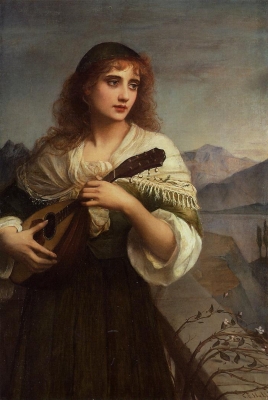
Pre-Raphaelite (1848 to 1854 AD)
In the mid-1800s, as the mass industrialisation and politicisation swept Britain into turmoil, seven men began a secret art society called the Pre-Raphaelite Brotherhood. The aim of this society was to bring to light the moral high ground and purity of art that pre-dated Renaissance master Raphael. As old colleagues of the Royal Academy of Art, they were disenchanted by the workings of modern academic art and had great respect for the early Renaissance period.
The three main painters associated with this movement were William Holman Hunt, John Everett Millais and Dante Gabriel Rossetti. Their paintings were initially signed ‘PRB’, which brought in a lot of curiosity, hatred and appreciation. Their subjects were mythological, biblical, and later, associated with literature and poetry. They painted art in sharp focus. The lack of shadows and depth, along with the bright palettes, made the paintings look flat.
Their wistful notion of spells and dreams were the basis for a future form of art called Surrealism and even Fruedism. The art, although mythological and painted in maximum realistic sense, also urged viewers to contemplate aspects such as family, justice and the fight against corruption.
As Pre-Raphaelite art grew more popular, the painters got more involved in decorative arts. Furniture, murals textiles and jewellery became a part of their artistic repertoire. The movement was short-lived and the artists soon disbanded.
Wow facts
- A lot of Pre-Raphaelite characters were based on women known to artist Dante Gabriel Rossetti. They were tall, had long red hair and a stiff pose. Usually, the women were caught in a wistful moment, with dreamy eyes staring into the distance.
- Although a lot of the paintings were on religious themes, literature also provided them with ample inspiration. Shakespearean plays or poems by Lord Alfred Tennyson were often the base for the art. “The Lady of Shalott” by John William Waterhouse is inspired by Tennyson’s poem of the same name.
Example
Ophelia: Painted by Sir John Everett Millais between 1851 and 1852, the painting depicts Ophelia, a character from Shakespeare’s play “Hamlet”. It depicts the part where Ophelia sings as she floats in a lake, before she drowns. The seen is not usually seen on stage as a part of the play but is described by another character.
Beata Beatrix: Dante Gabriel Rossetti painted this in 1870; the name translates to ‘Blessed Beatrix’. It is based on a story that Rossetti liked as a child. Dante modelled Beatrix after his wife and model Elizabeth Siddal. The painting remains one of the prime examples of Pre-Raphaelite art.
The lady of Shalott: Painted by John William Waterhouse, this oil-on-canvas paints a picture of Lord Alfred Tennyson’s poem of the same name where he describes the plight of a young woman with unrequited love. The painting is in sharp focus and with bright colours, like other paintings of that era.
Picture Credit : Google




